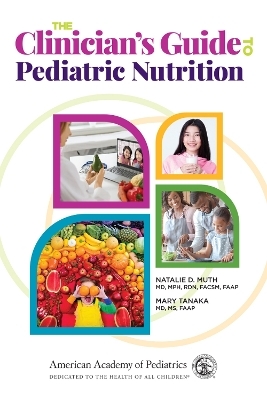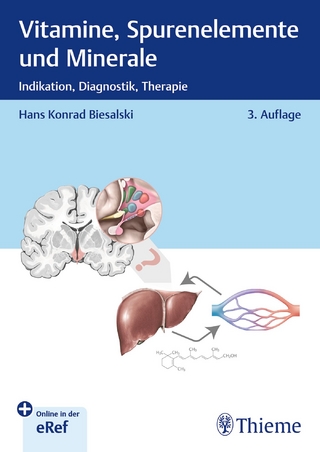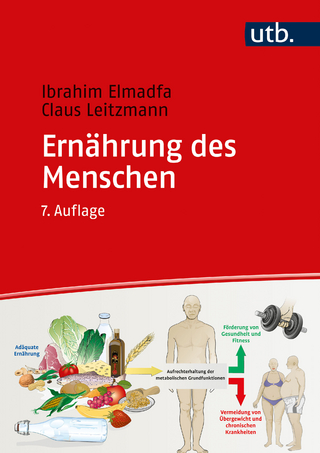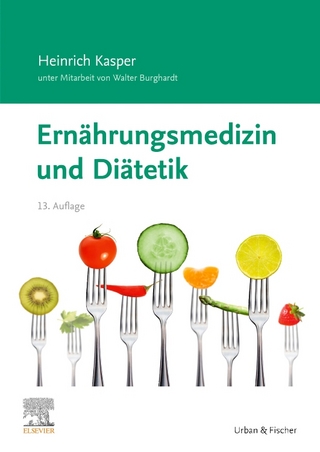
The Clinician's Guide to Pediatric Nutrition
American Academy of Pediatrics (Verlag)
978-1-61002-661-1 (ISBN)
This new reference provides primary care clinicians with essential nutrition information, guidance, tools, and resources that are needed to offer patients optimal care concerning nutrition in the primary care setting.
In addition, it includes tables designed for at-a-glance reference throughout the chapters, case studies for further learning, nutritional recipes for daily meals, and a frequently asked questions section to address caregivers’ and patients’ questions.
With this authoritative reference, clinicians will learn how to
Take a nutrition history.
Evaluate growth and development, weight and adiposity, and signs of nutritional deficiency or excess.
Complete a nutrition assessment and provide a patient-specific nutrition treatment plan.
Select and interpret findings from screening and laboratory tests and diagnostic procedures to assess and manage a patient’s nutrition.
Use behavioral change strategies and coaching techniques matched to a patient and family’s readiness for change, including motivational interviewing, SMART goal setting, problem-solving, self-monitoring, stimulus control, and the 5 A’s (ask, assess, assist, advise, arrange).
Provide age-specific nutrition guidance for infants, toddlers, preschoolers, school-aged children, and adolescents based on the most up-to-date information, including the Dietary Guidelines for Americans, 2020–2025.
Effectively incorporate scientifically sound nutrition guidance into the treatment of common pediatric concerns, including anemia, reflux, constipation, underweight, childhood overweight and obesity, dyslipidemia, prediabetes, fatty liver disease, hypertension, disordered eating, attention-deficit/hyperactivity disorder, and autism spectrum disorder.
Consult or refer to registered dietitians and other health care professionals and community resources as appropriate.
Screen for food insecurity and connect families with public health resources.
Confidently answer the most commonly asked nutrition questions from parents and patients.
Advise patients and families on how to integrate nutrition principles into everyday life including through application of culinary medicine.
Natalie D. Muth, MD, MPH, RDN, FACSM, FAAP is a primary care pediatrician and registered dietitian at Children's Primary Care Medical Group (CPCMG) in Carlsbad, CA, where she is also the founder and director of the CPCMG W.E.L.L. healthy living and nutrition clinic. She also is an adjunct assistant professor at the University of California, Los Angeles (UCLA) Fielding School of Public Health where she teaches an undergraduate nutrition course, and she is a member of the Motivational Interviewing Network of Trainers. Dr Muth has published over 100 articles, book chapters, and books, including Family Fit Plan: A 30-Day Wellness Transformation (American Academy of Pediatrics, 2019), The Picky Eater Project: 6 Weeks to Healthier, Happier Family Mealtimes (American Academy of Pediatrics, 2016), the textbook Sports Nutrition for Allied Health Professionals (F.A. Davis, 2019), Coaching Behavior Change (American Council on Exercise, 2014), the ACE Fitness Nutrition Manual (American Council on Exercise, 2013), and Eat Your Vegetables! and Other Mistakes Parents Make: Redefining How to Raise Healthy Eaters (Healthy Learning, 2012). She holds a Bachelor of Science degree in psychology and physiological science from UCLA, and a Master of Public Health and Medical Doctor degree from the University of North Carolina-Chapel Hill. Mary Saph Tanaka, MD, MS, FAAP is a pediatrician at Children’s Primary Medical Group (CPCMG) in Carlsbad, California. After graduating with honors from the University of California, Los Angeles (UCLA) in mass communications, she received her graduate degree in complementary and alternative medicine at Georgetown University. Dr Tanaka received her medical degree from Georgetown University School of Medicine. She completed her internship and pediatric residency at UCLA Mattel Children’s Hospital, Community Health and Advocacy Training track (CHAT), and was recruited to stay as chief resident. As a military spouse, Dr Tanaka travelled around the country and practiced at Dayton Children’s Hospital in Ohio and Sacred Heart Pediatric Clinic and Eglin Air Force Base in northwestern Florida before settling in the San Diego area. In addition to her pediatric practice, Dr Tanaka helps families improve their health and wellness in the CPCMG W.E.L.L. Clinic. With her medical and nutrition expertise combined with her passion for cooking, Dr. Tanaka serves as the W.E.L.L Clinic’s culinary medicine expert. To help families learn how to prepare delicious and healthy meals, she created a virtual teaching kitchen curriculum where she shares cooking techniques and demonstrates recipes. Dr Tanaka has developed multiple child-friendly recipes for numerous publications and loves testing new dishes with her 2 sons and husband.
Introduction
Part 1 Nutrition Essentials
Chapter 1 Dietary Reference Intakes
Chapter 2 Carbohydrates
Chapter 3 Protein
Chapter 4 Fats
Chapter 5 Vitamins
Chapter 6 Minerals
Chapter 7 Water and Hydration
Part 2 Nutritional Assessment
Chapter 8 Anthropometrics
Chapter 9 Clinical and Biochemical Evaluation
Chapter 10 Dietary and Social History
Part 3 Nutritional Counseling
Chapter 11 The Dietary Guidelines and Principles of Healthy Eating
Chapter 12 Healthy Eating Plans
Chapter 13 Culinary Medicine and Strategies for Healthy Eating
Chapter 14 Theories of Behavior Change and Motivational Interviewing
Chapter 15 SMART Goals and Action Plans
Part 4 Nutrition Prescription
Chapter 16 Nutrition in Infancy
Chapter 17 Nutrition in Childhood and Adolescence
Chapter 18 Sports and Athletic Performance
Chapter 19 Mental Health, Behavioral, and Developmental Conditions
Chapter 20 Obesity and Related Comorbidities
Chapter 21 Nutrition for Common Gastrointestinal, Autoimmune, and Inflammatory Conditions
Part 5 Frequently Asked Questions, Case Studies, and Recipes
Frequently Asked Questions
Case Studies
Recipes
Appendix: The Dietary Reference Intake Tables
Index
| Erscheinungsdatum | 16.02.2023 |
|---|---|
| Verlagsort | Elk Grove Village |
| Sprache | englisch |
| Maße | 152 x 231 mm |
| Gewicht | 680 g |
| Themenwelt | Medizin / Pharmazie ► Allgemeines / Lexika |
| Medizin / Pharmazie ► Gesundheitsfachberufe ► Diätassistenz / Ernährungsberatung | |
| Medizin / Pharmazie ► Medizinische Fachgebiete ► Pädiatrie | |
| Medizin / Pharmazie ► Pflege ► Fachpflege | |
| Medizin / Pharmazie ► Pflege ► Kinderkrankenpflege | |
| ISBN-10 | 1-61002-661-6 / 1610026616 |
| ISBN-13 | 978-1-61002-661-1 / 9781610026611 |
| Zustand | Neuware |
| Informationen gemäß Produktsicherheitsverordnung (GPSR) | |
| Haben Sie eine Frage zum Produkt? |
aus dem Bereich


